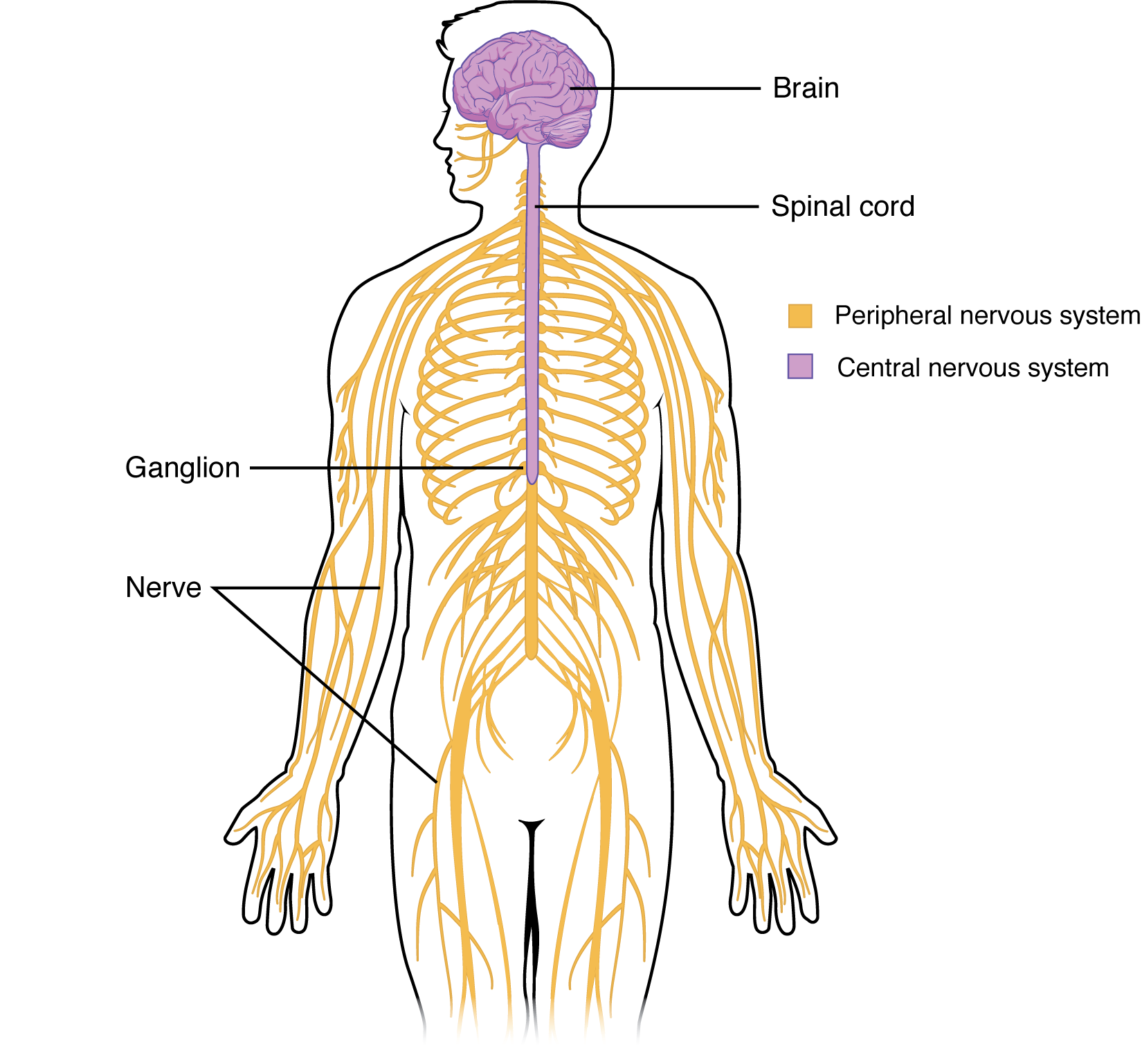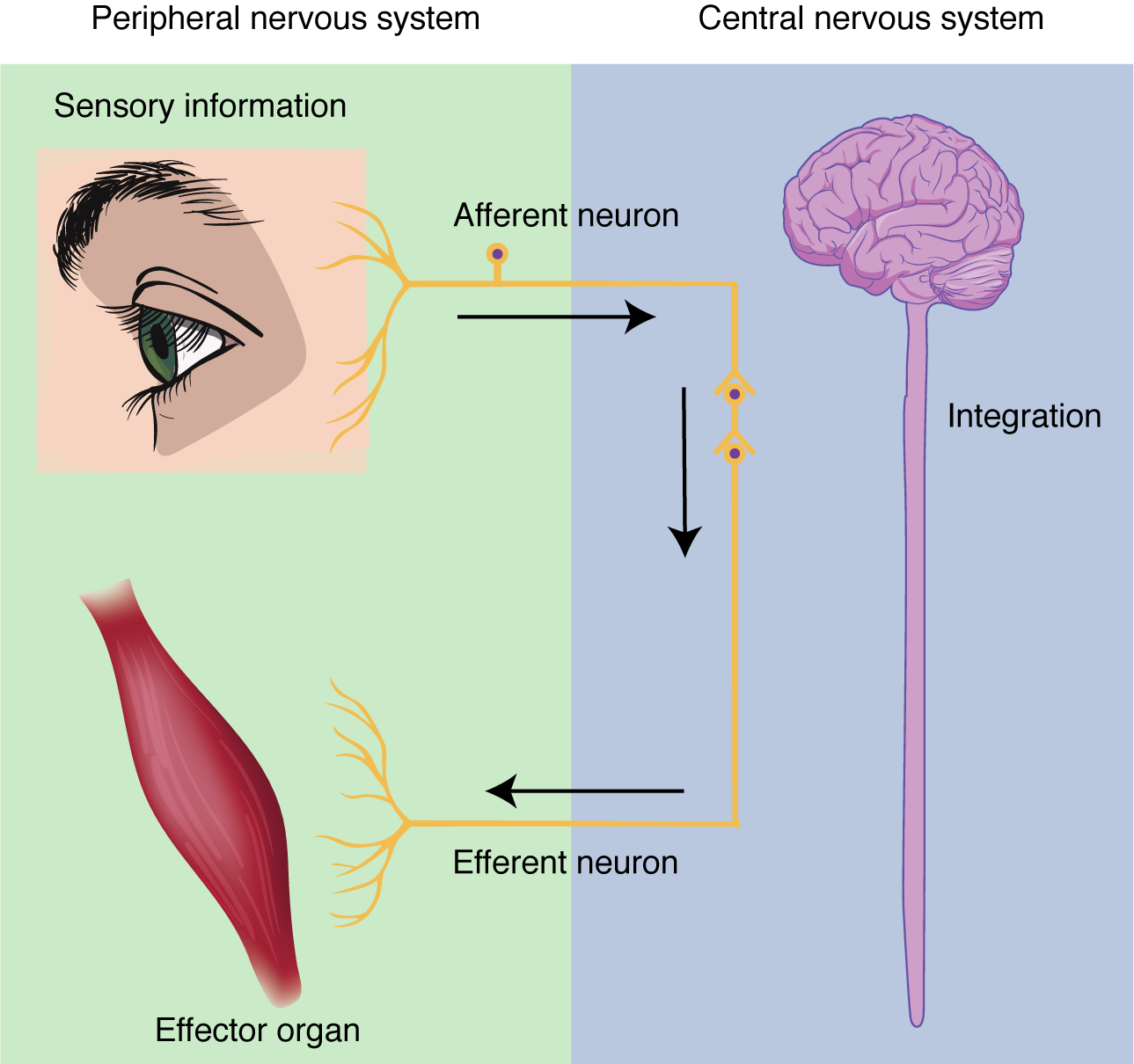12.1 Structure and Function of the Nervous System
Learning Objectives
By the end of this section, you will be able to:
Relate the anatomical structures to the basic functions of the nervous system.
- Identify the anatomical and functional divisions of the nervous system
- List the basic functions of the nervous system
The Central and Peripheral Nervous Systems
The picture you have in your mind of the nervous system probably includes the brain, the nervous tissue contained within the cranium, and the spinal cord, the extension of nervous tissue within the vertebral column. Additionally, the nervous tissue that reach out from the brain and spinal cord to the rest of the body (nerves) are also part of the nervous system. We can anatomically divide the nervous system into two major regions: the central nervous system (CNS) is the brain and spinal cord, the peripheral nervous system (PNS) is the nerves (Figure 12.1.1). The brain is contained within the cranial cavity of the skull, and the spinal cord is contained within the vertebral canal of the vertebral column. The peripheral nervous system is so named because it is in the periphery—meaning beyond the brain and spinal cord.

Functional Divisions of the Nervous System
In addition to the anatomical divisions listed above, the nervous system can also be divided on the basis of its functions. The nervous system is involved in receiving information about the environment around us (sensory functions, sensation) and generating responses to that information (motor functions, responses) and coordinating the two (integration).
Sensation. Sensation refers to receiving information about the environment, either what is happening outside (ie: heat from the sun) or inside the body (ie: heat from muscle activity). These sensations are known as stimuli (singular = stimulus) and different sensory receptors are responsible for detecting different stimuli. Sensory information travels towards the CNS through the PNS nerves in the specific division known as the afferent (sensory) branch of the PNS. When information arises from sensory receptors in the skin, skeletal muscles, or joints, it is transmitted to the CNS using somatic sensory neurons; when information arises from sensory receptors in the blood vessels or internal organs, it is transmitted to the CNS using visceral sensory neurons.
Response. The nervous system produces a response in effector organs (such as muscles or glands) due to the sensory stimuli. The motor (efferent) branch of the PNS carries signals away from the CNS to the effector organs. When the effector organ is a skeletal muscle, the neuron carrying the information is called a somatic motor neuron; when the effector organ is cardiac or smooth muscle or glandular tissue, the neuron carrying the information is called an autonomic motor neuron. Voluntary responses are governed by somatic motor neurons and involuntary responses are governed by the autonomic motor neurons, which are discussed in the next section.
Integration. Stimuli that are detected by sensory structures are communicated to the nervous system where information is processed. In the CNS, information from some stimuli is compared with, or integrated with, information from other stimuli or memories of previous stimuli. Then, a motor neuron is activated to initiate a response from the effector organ. This process during which sensory information is processed and a motor response generated is called integration (see Figure 12.1.2 below).

Chapter Review
The nervous system can be separated into divisions on the basis of anatomy and physiology. The anatomical divisions are the central and peripheral nervous systems. The CNS is the brain and spinal cord. The PNS is everything else and includes afferent and efferent branches with further subdivisions for somatic, visceral and autonomic function. Functionally, the nervous system can be divided into those regions that are responsible for sensation, those that are responsible for integration, and those that are responsible for generating responses.
Review Questions
Critical Thinking Questions
1. What responses are generated by the nervous system when you run on a treadmill? Include an example of each type of tissue that is under nervous system control.
2. When eating food, what anatomical and functional divisions of the nervous system are involved in the perceptual experience?
Glossary
- autonomic nervous system
- functional division of the efferent branch of the PNS that is responsible for control of cardiac and smooth muscle, as well as glandular tissue
- brain
- the large organ of the central nervous system contained within the cranium and continuous with the spinal cord
- central nervous system (CNS)
- anatomical division of the nervous system that includes the brain and spinal cord
- integration
- nervous system function that processes sensory perceptions and produce a response
- peripheral nervous system (PNS)
- anatomical division of the nervous system that extends from the brain and spinal cord to the rest of the body
- response
- nervous system function that causes a target tissue (muscle or gland) to produce an event as a consequence to stimuli
- sensation
- nervous system function that receives information from the environment and translates it into the electrical signals of nervous tissue
- somatic nervous system (SNS)
- functional division of the nervous system that is concerned with conscious perception, voluntary movement, and skeletal muscle reflexes
- spinal cord
- organ of the central nervous system found within the vertebral cavity and connected with the periphery through spinal nerves; mediates reflex behaviors
- stimulus
- an event in the external or internal environment that registers as activity in a sensory neuron
Solutions
Answers for Critical Thinking Questions
- Running on a treadmill involves contraction of the skeletal muscles in the legs (efferent somatic motor), increase in contraction of the cardiac muscle of the heart (efferent autonomic motor), and the production and secretion of sweat in the skin to stay cool (sensation of temp = afferent visceral sensory, sweat gland activation = efferent autonomic motor).
- The perceptual experience of eating food refers to tasting food, both in terms of flavors and texture. The neurons responsible for sensing taste are afferent somatic neurons of the PNS.
This work, Anatomy & Physiology, is adapted from Anatomy & Physiology by OpenStax, licensed under CC BY. This edition, with revised content and artwork, is licensed under CC BY-SA except where otherwise noted.
Images, from Anatomy & Physiology by OpenStax, are licensed under CC BY except where otherwise noted.
Access the original for free at https://openstax.org/books/anatomy-and-physiology/pages/1-introduction.

